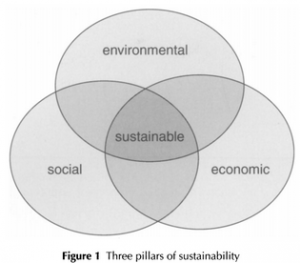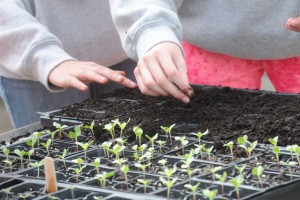Social Context

In order to best understand how the solar powered wash station will serve LaFarm, it is important to first understand the value and role of LaFarm viewed through a series of contextual lenses. During the process of design and implementation of the solar powered wash station at LaFarm, we have defined the social context analysis to include four influential contexts that include historical, user, campus/community and environmental. While these 4 contexts shape our social context, the social context must be considered in conjunction with others to understand the role of this socio-technical system. Sustainability is not just a social or technical consideration but instead “to be sustainable something must be simultaneously economically, socially and environmentally sustainable” (Maxwy L., 2006).
Historical Context
When evaluating the importance of LaFarm and its mission, one must understand the historical context of small scale campus farms and how it ties into Lafayette’s reasoning behind the expansion of LaFarm. Beginning primarily in the 1960’s and 1970’s, during a time of emphasis on social change (specifically in the engineering and industrial disciplines), questions regarding food production safety and sustainability began to arise. During this period arose questions by students on college campuses about where their food was coming from and how they could make this process not only more transparent, but also more sustainable. An early template of a sustainable, educational campus farm, the campus farm at Evergreen State College in Olympia, Washington, educated one of the first groups of students who were taught to experience farming. It emphasized that “sustainability is proposed as a tool to facilitate questioning, analysis and action. It is understood… as a process rather than a definitive end point and key to this process is opening up not only active engagement but also the construction of norms and agendas to all actors” (Maxwy L., 2006).
The efforts of Evergreen State College and its students to better understand how food is a socio-technical system that fits into everyday life is comparable to Lafayette College’s efforts at LaFarm. With Lafayette College’s history rooted in agrarian practices (Skillman, 1932, p. 67), students and faculty alike find it important to understand our relationship with food and the power that it can give local people and places.
The historical context of small scale campus farming ties in with LaFarm’s educational initiative. The unique lessons that can be learned from working on a community farm are best articulated by Wendall Berry, author of “The Agrarian Standard”, who noted that “a function of ‘industrial education’ over the years has been to ‘preserve and protect an ignorance of local people and places’… This is how the worst of global and national economies operate. By contrast, in a local economy, people are more likely to ask and answer such questions as, ‘Did I do that?’ ‘What will this do to our water supply?’ or, ‘Is it healthy?’. Participants in this economy will be less likely to accept damaging outcomes” (Bramwell S. et al, 2011).
After having discussed with Sarah Edmonds her vision for LaFarm, we have a better sense of LaFarm and its place within its own timeline of continued improvement and grander aspirations. Sarah hopes that an environmental campus will one day be built on Metzgar Fields with LaFarm as its main attraction. This will enable more students to play larger role in the production of fresh local produce. This undoubtedly informs our design and implementation of a wash station. Based on Sarah’s vision for LaFarm, there are both short-term and long-term goals that need to be met.
Campus/ Community Context
At it’s core, LaFarm is a community farm. The purpose of LaFarm is to provide a space for community members, students and faculty to come together to farm, learn and work together towards a common goal of local sustainable farming. The combined contribution and expectations of Easton community members and Lafayette community members places community and campus context at an increased importance.
Important to take into consideration is that LaFarm grows and sells much of their produce to Bon Appetite, Lafayette’s dining services. This give students and Bon Appetite a direct stake in how LaFarm is operated. The use of locally grown food contributes to Bon Appetite’s initiative to be a customer and supporter of local farmers. This initiative is an important aspect to the socially and environmentally concerned member of the campus and community.
The goal of LaFarm is to be an educational farm for both the community and campus and has no desire to take away business from other small farms in the area. That being said, LaFarm does hope to achieve recognition and respect for being a revenue gaining, sustainable farm that does not require donations to function. This self-sustaining image is desired in order to be used as a template for other community and campus farms who hope to also incorporate technology, specifically solar powered, into their operations. Lafayette College and LaFarm recognize this need and take it into consideration when analyzing the funding stream for this project.
User Context
The solar powered wash station that we are planning to design and implement into the workflow of LaFarm will affect all the users of LaFarm. No longer will the farmers at LaFarm have to use the existing, decaying wash station that currently stands on the LaFarm property behind the toolshed . The wash station that is currently at LaFarm was assembled with donated materials, connected via hose to the water system and does not meet new regulation for small scale farms. With this new wash station, LaFarm will achieve more credibility in the farming community and can be used as an educational template for other small scale farms.
LaFarm is unique as its users of the land and equipment include students, staff, faculty and community members. This diverse audience is important when taking into consideration how the users may accept and use a new wash station. LaFarm and the wash station should fit the mold the Easton and Lafayette community has set forth in creating an educational and sustainable farm.
“Users” of LaFarm one degree removed, the students and other individuals who consume the food from LaFarm, hold a stake in how LaFarm is run and especially in the technology that cleans the food they are eating. When dealing with something as personal as the food that people consume it is pertinent that we understand the role that locally grown food plays in a campus structure. The food loop that Lafayette and other small scale farms are trying to achieve is not a singular process but instead a system and it is important to understand “the notion of sustainable food, recognizing that food, like everything else, is embedded in a host of heterogenous processes and contexts” (Maxwy L., 2006).
Environmental Context
The environmental context is an important, overarching context that introduces the policy and technical analyses to follow. Driving the environmental aspect of this project is the environmental benefit resulting from a local, sustainable farm. Within Lafayette and LaFarm’s food loop, food is produced, consumed and disposed in a cycle that reduces waste, unnecessary chemical use and lessens travel emission. On an environmentally aware campus like Lafayette’s, LaFarm’s food loop holds value to students in a time in which “a growing number of consumers and producers in supporting organic farming and a host of other ‘alternative’ food networks” (Maxwy L., 2006).

The incorporation of the existing solar panels connected to the irrigation system we plan to use emphasized the self-sustainability of the wash station. Using no outside power source, the wash station will not be consuming power to wash vegetables. This contributed credibility to LaFarm as a self-sustainable farm and allows it to be better used by other small scale farms as a sustainable template.
In conjunction with LaFarm’s educational objective, students learn to farm within the constraints of their existing environment. These constraints include limitations associated with climate change, natural stress as well as time and space constraints (Stinger L. C. et al, 2008). The lesson that LaFarm can offer to its student, faculty and community farmers is an important one as the reality of climate change is affecting lifestyles, ecosystems and policy around the word. The environmental educational experience achieved from small scale farming reach far beyond the just community or campus. This benefit is very well articulated in “The Evergreen State College” chapter of Fields of Learning “When a student manages the on campus farm stand, he or she is helping provide vegetables to the campus community in a way that directly substitutes for vegetables imported from California or elsewhere, sidestepping the industrial food chain with all its petroleum dependency, trade inequities, and pollution woes” (Bramwell S. et al, 2011).
